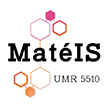In situ and/or 3D microstructural characterisation
The laboratory has a large range of experimental methods at its disposal enabling us to carry out 3D imaging on optically opaque materials on scales ranging from one nanometre to a hundred micrometers or so. The techniques enabling us to cover the different scales range from X-ray tomography (laboratory or synchrotron source) and focused ion beam tomography to scanning electron microscopy and transmission electron microscopy (in an increasing order of resolution).
- X-ray tomography lends itself well to in situ experiments and a lot of equipment has been developed within the laboratory to enable us to observe the evolution of the microstructure of samples being heated and cooled etc. subject to monotonous, cyclical, uniaxial tensile compression, torsion and isostatic pressure mechanical loading. A very important extension to the technique used in crystalline orientation characterisation (Diffraction Contrast Tomography – DCT) has been recently developed in close collaboration with the ESRF.
- Electronic tomography covers scales that complement one another. Owing to the constraints linked to the acquisition of data (limited tilt angular amplitude, variation in contrast during sample rotation etc.), ad hoc reconstruction techniques and/or special object holders have already been or are currently being developed. Some « firsts » have incidentally been achieved, particularly in view of the environment, with both a scanning electron microscope and a transmission microscope. Environmental electron microscopy is in fact one of the laboratory’s main strengths since its enables us to study nanomaterials in their environment (water, gas) and/or when subject to loading (thermal, chemical and mechanical).
To find the tomographers available in the laboratory, see here.

